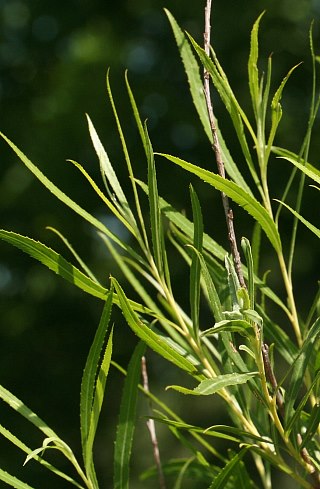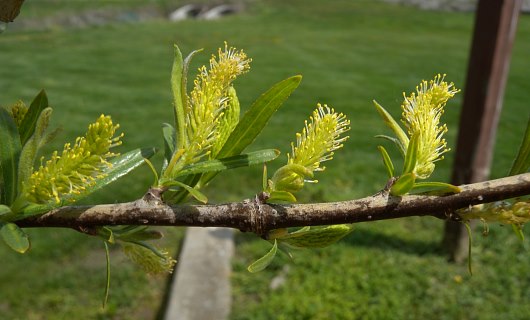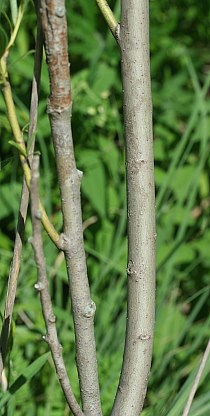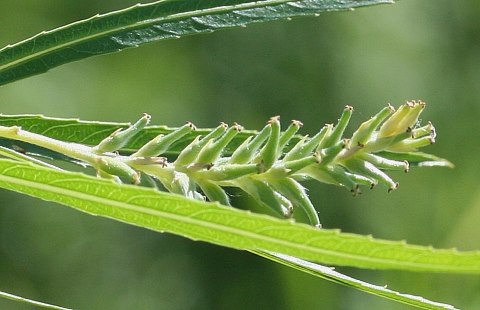Description: This shrub has two growth forms: a small tree up to 20' tall with a trunk up to 6" across, or a thicket of little-branched woody stems up to 8' tall. An older tree develops gray flaking bark on its trunk, while the trunk bark of younger trees is gray and more smooth. Woody branches and slender stems are variably colored, but often gray or yellowish-brown and smooth. The alternate leaves are up to 5" long and 2/5" (1 cm.) across; they are linear in shape and remotely denticulate along their margins (small distinct teeth that are widely spaced). Mature leaves are usually hairless; their upper surfaces are medium green, while their lower surfaces are pale green. At the base of each leaf, there is a short petiole that is hairless and light green. Sandbar Willow is dioecious: male florets and female florets are produced on separate plants in the form of catkins. Whether male or female, a catkin consists of a raceme of florets that are arranged in a spiraling pseudo-whorl.

Male catkins are ¾–2" long and narrowly cylindrical in shape; they are erect, ascending, or lean sideways. Each male floret consists of a pair of stamens and a single oblong-oval bract that is deciduous; there are neither petals nor sepals. The lower half of the filaments of the stamens are densely covered with short silky hairs; the anthers of the stamens are bright yellow. The bract is yellow and covered with short silky hairs. Female catkins are 1½–3" long and narrowly cylindrical; they are mostly green while immature, later becoming light brown. Each female floret consist of an ovoid-conic ovary about 5-9 mm. in length and a single oval-oblong bract that is deciduous. Both the ovary and bract are sparsely short-pubescent to hairless. At the apex of each ovary, there is a pair of tiny stigmas. The catkins usually develop at about the same time as the leaves from mid- to late spring. However, some shrubs bloom later during the summer. Each fertile ovary develops into a seed capsule that splits open into 2 parts to release numerous seeds that are minute and hairy. These seeds are distributed by the wind. The root system is branching and woody, often forming underground runners that develop into vegetative offshoots. Colonies of plants are often formed from these clonal offshoots.

Cultivation: The preference is full or partial sun and consistently moist to wet conditions. Different kinds of soil are tolerated, including those that are sandy, gravelly, silty, or loamy. This willow can spread aggressively from vegetative offshoots. Standing water is tolerated if it is temporary. A new willow shrub can be cultivated by breaking off a stem and sticking it into moist ground; new leaves will develop at the top while new roots develop below the ground surface. Willow seeds have a short period of viability; they must be scattered across moist ground within a week after the seed capsules split open.
Range & Habitat: The native Sandbar Willow has been collected from nearly all counties of Illinois (see Distribution Map); it is quite common and probably occurs in every county. Habitats include shrub swamps, borders of ponds and slow-moving rivers, gravel bars and sandbars, lake shore beaches, marshes, damp swales in prairies, and ditches. This weedy willow often appears in wet areas with a history of disturbance, and it can spread readily; it also reduces soil erosion.
appears in wet areas with a history of disturbance, and it can spread readily; it also reduces soil erosion.
Faunal Associations: The flowers are cross-pollinated by bees and flies. This includes honeybees, bumblebees, little carpenter bees (Ceratina spp.), cuckoo bees (Nomada spp.), Halictid bees (including green metallic bees & Halictid cuckoo bees), plasterer bees (Colletes spp.), masked bees (Hylaeus spp.), Andrenid bees (Andrena spp.), Syrphid flies, thick-headed flies (Conopidae), dance flies (Empididae), Tachinid flies, and Muscid flies. These flowers are also visited by various beetles, Sphecid wasps, and other wasps. Both nectar and pollen are available as floral rewards for such insect visitors. Many Andrenid bees are specialist pollinators (oligoleges) of willows, including Andrena andrenoides, Andrena bisalicis, Andrena erythrogaster, Andrena illinoiensis, Andrena mariae, Andrena nigrae, Andrena salictaria, and Andrena wellesleyana (Robertson, 1929; Krombein et al., 1979; Wilhelm & Rericha, 2017). A large number of insects also feed destructively on the leaves, catkins, bark and/or wood, plant sap, and other parts of Sandbar Willow and other willows. This latter group of insects includes the larvae of metallic wood-boring beetles, larvae of long-horned beetles, leaf beetles, weevils, larvae of leaf-mining flies, larvae of gall flies, plant bugs, stink bugs, aphids, spittlebugs, leafhoppers, armored scales, thrips, larvae of sawflies, and larvae of many moths and butterflies (see Insect Table). Butterfly larvae that feed on willows include the Mourning Cloak (Nymphalis antiopa), Compton Tortoiseshell (Nymphalis vau-album j-album), Viceroy (Limenitis archippus), and Acadian Hairstreak (Satyrium acadicum); larvae of a skipper, the Dreamy Duskywing (Erynnis icelus) also feeds on willows. These insects are an important food source for many insectivorus birds. Birds that eat the buds and/or catkins of willows include the Wood Duck, Northern Pintail, Mallard, Evening Grosbeak, Pine Grosbeak, White-crowned Sparrow, Common Redpoll, and Ruffed Grouse (DeGraaf, 2002; DeVore et al., 2004). Mammals that feed on willows include the American Moose and White-tailed Deer (twigs, foliage), Muskrat and Cottontail Rabbit (bark), and American Beaver (wood, bark). The American Black Bear, Fox Squirrel, Meadow Vole, and Prairie Vole feed on leaves, buds, and/or catkins (Martin et al., 1951/1961; Hamerstrom & Blake, 1939; Romain et al., 2013). Some turtles, like the Snapping Turtle and Wood Turtle, occasionally feed on the fallen leaves of willows (Ernst et al., 1994; Lagler, 1943), and the American Beaver often uses the branches of these trees and shrubs as construction material for their lodges and dams. Because the Sandbar Willow, in particular, often forms dense thickets of shrubs, it provides excellent cover for many kinds of wildlife.
Photographic Location: The photograph of the male catkins was taken at a city park in Champaign, Illinois, while the remaining photographs were taken at Meadowbrook Park in Urbana, Illinois.

Comments: This is probably the most common willow in Illinois. Without the assistance of a beaver colony, it is difficult to control and its use is not recommended for wetland restorations. While willows are often difficult to identify, the Sandbar Willow can be readily recognized by its long slender leaves with widely spaced teeth. Other similar willows have teeth that are more densely spaced along the margins of their leaves, or their leaves lack distinct teeth altogether. Sometimes the Sandbar Willow is referred to as Salix exigua.